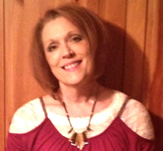Special Spotlight
Caroline Hall
Managing Editor, AAPT/ComPADRE Digital Library
Columbus, Ohio
My own pathway to physics education has been a circuitous one! After graduating from the University of Oklahoma with a degree in Journalism/Broadcast Communications, I set out to change the world through investigative reporting. Working in TV news was eye-opening and most days were fun, but the work was also often depressing. I wanted my work to uplift people, so I changed course and began a degree program in Education at the University of Dayton.
My first actual teaching job came shortly afterward when I took a job tutoring “special populations” for the Centerville, Ohio school district. To support myself in grad school, I tutored kids with substance abuse issues, serious illnesses or traumatic injuries who couldn’t physically attend school, and kids with such extreme behaviors that they were no longer allowed to attend school. I look back at this short time as my own period of greatest growth. These kids taught me more about commitment, courage, strength, and tenacity than I can possibly measure. From 2000-2004, I taught Language Arts and Math in middle school classrooms, two years at a high-needs school and two years at a suburban school in an upscale community. I taught students who fell outside the bell curve, which seems to be my niche.
I loved teaching, but my life changed dramatically in 2005 when my youngest son was diagnosed with autism. His struggles were so great that I left teaching to accept part-time work in educational outreach at the University of Oklahoma’s Department of Physics and Astronomy. It was during this time that I met Bruce Mason, professor of physics at O.U. Bruce offered me a job as Project Manager of the ComPADRE Digital Libraries. I watched Bruce teach and knew that he was an inspirational educator. I jumped at the chance to work with him in building ComPADRE from the ground up. Bruce and Wolfgang Christian have served as my mentors and close colleagues ever since. My work expanded from project management to curation for ComPADRE’s intro physics collections to assembling special collections, social media, and public outreach. When the ComPADRE grant ended in 2013, AAPT stepped up to help support the digital libraries.
The motivation for building AAPT Digi Kits stemmed from attending an AAPT meeting when a high school teacher asked for help in meeting the expanded expectations of science educators, resulting from the adoption of NGSS. Her plea still sticks in my mind: “Where can we find top-notch resources that let me integrate physics and biology (or physics and Earth science) without reinventing wheels? Is there any place online that has lessons, labs, simulations, background information, videos, and pedagogy all rolled into one collection?” After a discussion with AAPT K-12 Program Manager Rebecca Vieyra in 2015, Digi Kits were born! With the input of The Physics Teacher’s Gary White and Pamela Aycock, we built the Digi Kits around hands-on investigations inspired by articles in The Physics Teacher. Each Digi Kit offers vetted resources to support interdisciplinary learning. For example, Nerve Science blends physics and biology as students use a vinyl tube filled with salted gelatin to model how an electrical impulse travels along an axon. The digital resources include computational models, visualizations and animated tutorials of the action potential in neurons, plus background on how these biological processes are governed by principles of flow and resistance we study in physics. We’ve now completed 10 Digi Kits, and the positive response from teachers has been overwhelming.
I’ve been deeply honored to be part of the Digi Kit production. I also do private consulting work for the Concord Consortium, The Physics Classroom website, NASA, PBS Learning Media, and Denver Public Schools. If you asked me to define my life’s best work, I would have to answer, "Raising Jeffrey and Dougie, my two phenomenally talented sons."


